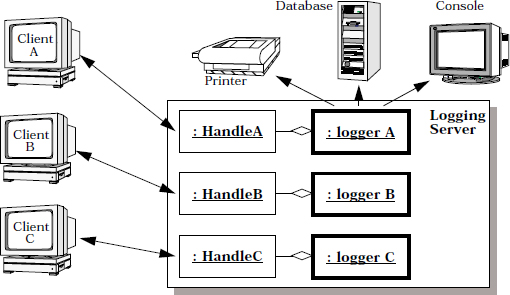Thread-Specific Storage
The Thread-Specific Storage design pattern allows multiple threads to use one ‘logically global’ access point to retrieve an object that is local to a thread, without incurring locking overhead on each object access.
Also Known As
Thread-Local Storage
Example
Consider the design of a multi-threaded network logging server that remote client applications use to record information about their status centrally within a distributed system. Unlike the logging server shown in the Reactor pattern example (179), which demultiplexed all client connections iteratively within a single thread, this logging server uses a thread-per-connection [Sch97] concurrency model to process requests concurrently.

In the thread-per-connection model a separate thread is created for each client connection. Each thread reads logging records from its associated TCP Socket, processes these records and writes them to the appropriate output device, such as a log file or a printer.
Each logging server thread is also responsible for detecting and reporting any low-level network conditions or system errors that occur when performing I/O. Many operating systems, such as UNIX and Windows NT, report this low-level information to applications via a global access point, called errno. When an error or unusual condition occurs during system calls, such as read() or write(), the operating system ...
Get Pattern-Oriented Software Architecture, Volume 2, Patterns for Concurrent and Networked Objects now with the O’Reilly learning platform.
O’Reilly members experience books, live events, courses curated by job role, and more from O’Reilly and nearly 200 top publishers.

